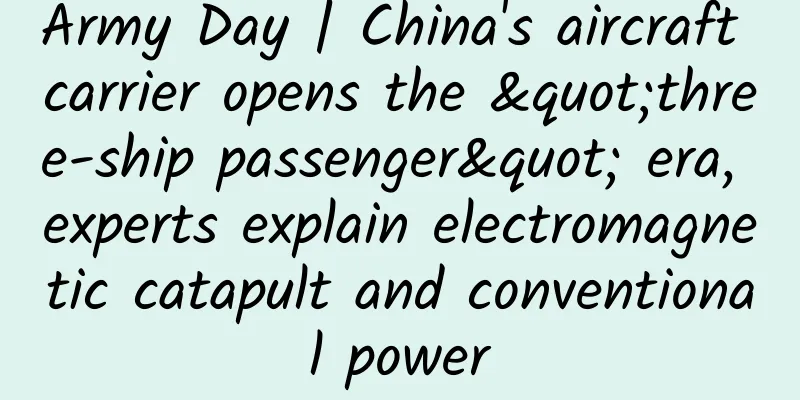Army Day | China's aircraft carrier opens the "three-ship passenger" era, experts explain electromagnetic catapult and conventional power

|
Today is the Army Day. For 95 years, we have overcome difficulties and braved the wind and waves, from the millions of wooden boats that crossed the Yangtze River to the aircraft carrier formations and fleets that sailed into the deep blue. Striking in the middle of the stream and conquering the sea and sky, the People's Army has written a magnificent track in the distant seas and oceans with a broad-footed attitude. At 11:00 am on June 17, China's third aircraft carrier was launched. With the approval of the Central Military Commission, China's third aircraft carrier was named "People's Liberation Army Navy Fujian Ship" and its hull number was "18". This is the first catapult-type aircraft carrier designed and built entirely by China. China has since entered the era of three "ships" of aircraft carriers. Unlike the previous Liaoning and Shandong ships, which use traditional ski-jump takeoff methods, the Fujian ship is the first catapult-type aircraft carrier designed and built entirely by my country. It uses a straight flight deck, is equipped with electromagnetic catapults and arresting devices, and has a full load displacement of more than 80,000 tons. After the ship is launched, mooring tests and navigation tests will be carried out as planned. What are the advantages of electromagnetic catapults? What is the difference between conventional power and nuclear power? Researcher Tian Xiaochuan, chief expert of the China Society of Naval Architecture and Chief Scientific Communication Expert of Ship Engineering of the China Association for Science and Technology, explains to us. On the morning of June 17, the launching and naming ceremony of my country's third aircraft carrier was held at the Jiangnan Shipyard of China State Shipbuilding Corporation Limited (Photo source: Xinhua News Agency) Electromagnetic catapult and steam catapult each have their own advantages and disadvantages. Unlike the Liaoning and Shandong ships, the Fujian ship, as China's third aircraft carrier, is the first catapult-type aircraft carrier designed and built entirely independently in China. Tian Xiaochuan, chief expert of the China Society of Naval Architecture and Shipbuilding, said that there are several take-off methods for aircraft carriers currently in service in various countries around the world: for example, China's Liaoning and the J-15 on the Shandong use traditional ski-jump take-offs ; the US Nimitz nuclear-powered aircraft carrier uses steam catapults ; the US Ford aircraft carrier uses electromagnetic catapults ; and the British Navy's Queen Elizabeth-class aircraft carrier uses vertical short take-off and landing . The J-15 on the Liaoning aircraft carrier took off using a ski-jump takeoff method (Photo source: Xinhua News Agency) Regarding the advantages of electromagnetic catapults, Tian Xiaochuan said: "In order to develop the so-called 'latest aircraft carrier in the 21st century', the US Navy has made 23 technological breakthroughs, one of which is electromagnetic catapults." The electromagnetic catapult and steam catapult have different working principles. The former uses electricity as its "energy source" while the latter uses steam thermal energy. Steam catapults use engines to heat water into high-temperature steam, which then releases potential energy. In the process, there is inevitably a large energy loss. The US Navy's Nimitz aircraft carrier has used steam catapults for decades. In addition to its fast catapult speed, its biggest advantage is its mature technology. Electromagnetic catapults use electricity directly and can more accurately regulate output power, which is conducive to precise acceleration of aircraft of different models and missions. In other words, it can launch fighters weighing dozens of tons as well as relatively light drones. "Of course, electromagnetic catapults have advantages and disadvantages," said Tian Xiaochuan. For example, after the USS Ford entered service, it was discovered during the experiment that the electromagnetic catapult had many technical faults. One of them was very interesting. For example, its electromagnetic catapults could not be used at the same time. If one of the electromagnetic catapults had a problem, the other one would also have an accident. This is rare in steam catapults. Schematic diagram of electromagnetic catapult (Image source: NetEase) Conventional power and nuclear power are different? Contrary to previous speculation by netizens, the Fujian ship uses conventional power, not nuclear power. As for why the Fujian ship did not use nuclear power, Tian Xiaochuan explained that the development of nuclear-powered aircraft carriers and conventional-powered aircraft carriers was discussed for a long time by the US Navy in the 1960s and 1970s. When the US Navy was developing the nuclear-powered aircraft carrier Enterprise, there was a long dispute. For nuclear power, its biggest advantage is that it can be refueled less frequently throughout its life cycle, which means that it will be repaired less frequently and can sail around the world. The retired USS Enterprise nuclear-powered aircraft carrier. (Photo source: NetEase) "But the cost of developing a nuclear-powered aircraft carrier is high and the technology is difficult," said Tian Xiaochuan. Moreover, even if a nuclear-powered aircraft carrier is well protected during combat, once a nuclear leak occurs, it will pose a great threat to the surrounding environment. Therefore, there were many disputes within the United States at that time about nuclear-powered aircraft carriers. Therefore, after the development and construction of the Enterprise, the U.S. Navy designed the conventional-powered Kitty Hawk-class aircraft carrier, which shows that they had been entangled on this issue. However, the weaknesses of conventional power are also obvious, such as the small combat radius and the limited technology to meet the needs of carrier-based aircraft takeoff. The United States finally chose a nuclear-powered aircraft carrier. Kitty Hawk-class conventional-powered aircraft carrier (Photo source: NetEase) The advantages of nuclear-powered aircraft carriers in terms of endurance are obvious, but their weaknesses such as material replacement and overhaul are also obvious. What needs special attention is nuclear safety. In addition to maintaining peace, what other uses do aircraft carriers have? With the official launch of the Fujian ship, the Chinese Navy will have three aircraft carriers. In addition to maintaining peace, what other uses do aircraft carriers have? Tian Xiaochuan said that when an aircraft carrier is an offensive weapon, combat is its mission, especially ocean-going combat. However, during World War II, aircraft carriers were divided into many categories, including offensive aircraft carriers and escort aircraft carriers. After World War II, these aircraft carriers were unified into today's aircraft carriers. In terms of combat, we classify aircraft carriers into combat missions and non-combat missions. Non-combat missions refer to the role of maintaining peace. Aircraft carriers frequently appear in various disasters around the world . The fundamental reason is that aircraft carriers have advantages that ordinary fleets cannot match. The disaster relief advantages of aircraft carriers can be simply described as "multi-functional and highly efficient." First, aircraft carriers have a wide variety of carrier-based aircraft that can play a comprehensive role. For example, in disaster areas caused by tsunamis, transportation facilities are usually completely destroyed and almost become "isolated islands". If there are no conditions suitable for warships to dock and land, we can only rely on aircraft carriers to quickly approach the disaster area. Helicopters on aircraft carriers can arrive quickly and directly airdrop supplies; carry out aerial search and rescue and transport rescue soldiers and wounded. **The aircraft carrier is equivalent to a "mobile air base". It can not only carry a large amount of food, medicine and other supplies to provide protection for the needs of the disaster area, but also has a hospital and sufficient shelter space to accommodate enough rescue personnel and victims. In the special case where the infrastructure in the disaster area is severely damaged and there are many casualties, the seriously injured can go directly to the aircraft carrier for emergency medical treatment, and most medical rescue activities, including surgical operations, can be carried out smoothly, which is much stronger than the rescue capabilities of ordinary medical rescue teams. At the same time, there are seawater purification equipment on the aircraft carrier, which can produce a large amount of clean fresh water to provide drinking water and necessary living water for the victims. "In addition to maintaining peace, our aircraft carriers also conduct rescue training during training. Once some disaster occurs at sea, we also have the mission of carrying out humanitarian rescue," said Tian Xiaochuan. In recent years, with the improvement of China's military strength, Chinese soldiers can always be seen in international peacekeeping and disaster relief. The Chinese Navy has also actively participated in overseas humanitarian relief operations many times. On August 31, 2010, the 10,000-ton Peace Ark hospital ship designed and manufactured by China carried 428 officers, seamen and medical staff to ports in Djibouti, Kenya, Tanzania, Seychelles and Bangladesh. This "mobile hospital" with 500 beds and 8 operating rooms provided free medical assistance to people along the way. When evacuating Chinese citizens from Libya in 2011, some media outlets urged that relying solely on local resources and "rented" equipment would not be enough to meet the increasingly difficult operations, and that we needed to have our own "evacuation tools." "The Great Wall is at the bow of the ship. The three Chinese aircraft carriers serve as peace messengers at sea, guarding our peaceful lives," said Tian Xiaochuan. Source: Beijing Science and Technology News (Reporter Chen Yongjie) |
<<: I never thought that air conditioning could cause heat stroke?!
Recommend
Introduction to 360 mobile resource advertising promotion display formats!
Mobile resources: six advertising formats to meet...
SMS promotion is ineffective. What is the correct approach to SMS marketing?
In our daily lives, we are overwhelmed by marketi...
The road is slippery on snowy days. Here is a biomechanical guide to help you fall properly.
Heavy snow has fallen across the northern part of...
How do mini programs obtain traffic? How to get traffic for your mini program?
Zhang Xiaolong once mentioned in a WeChat open cl...
Why do most people not remember anything before the age of 3?
Friends Try to recall Do you remember what happen...
What are some free online marketing promotion methods?
1. Soft article promotion Soft article promotion ...
Query the price of Artair Real Estate Mini Program agent. How much is the price of Artair Real Estate Mini Program agent?
How much does the Ateler Property Agency Mini Pro...
How to optimize the account to stabilize oCPC second-order conversion?
With the popularity of oCPC , small and medium-si...
Experts responded that the patient was diagnosed despite negative nucleic acid and antibody test results! What exactly happened? Attached are the detailed reasons!
Everyone knows that the only way to detect the ne...
Biopharmaceutical companies carry out major strategic transformation: reversing the dilemma of digital transformation
Download the report: Add 199IT’s official WeChat ...
When programming languages meet superheroes, which one is the real one?
Each programming language has its own unique styl...
Why are fruits becoming sweeter and sweeter? Is this unhealthy?
Have you noticed that fruits are getting sweeter ...
The formula for creating popular educational short video content
In order to make a hit short video, in addition t...
Low-temperature burns may cause cancer! How to use portable heating equipment safely?
The first cold wave of the year is coming! Recent...
How to write Thanksgiving copy? Here are 8 tips for you!
As the name suggests, the festive element of Than...









